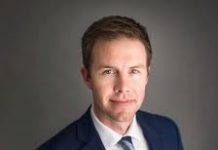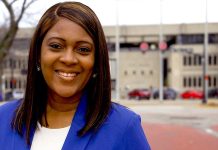Numbing democracy: Conspiracy theories and misinformation on social media divide neighbors
By Erica Irish
TheStatehouseFile.com
FRANKLIN, Ind.—The feeling of not breathing is what makes it a challenge for Heather Guess, 38, to wear a face-covering in public during the COVID-19 pandemic.
It’s one of many consequences of indelible trauma. The feeling is a reminder of when, as a young girl, a playmate shoved Guess and her sister into a dark chest freezer and locked the hatch. To this day, Guess struggles with tight spaces and crippling panic attacks. So in 2020, she changed her extroverted life to avoid people and what she said are inevitable conflicts with others in public.
“I have been argued with, I have been told I’m a liar, that I can wear a mask and I’m just choosing not to … and I’ve actually had people tell me that they hope I get the virus and die,†Guess said.
If the threats weren’t enough, the pandemic threw everything it had at Guess. She lost work as a traveling barista as the virus unfolded in spring 2020. Then, along with her husband and three young children, Guess was evicted from her Indianapolis apartment. After living in a hotel for three weeks, the family made it to their current residence in Franklin, Indiana, with the help of a local nonprofit.
The experience has made Guess question whether the state and local decisions made in the interest of public health are correct, including on the issue of masks.

Scientists around the world support masks as a way to protect each other and achieve herd immunity and would say Guess’s perspective is wrong or even harmful. Guess realizes this and is still skeptical: She wonders why people wear masks in the first place, arguing they prevent people’s biology from working as it should so they can build immunity. She continues to ask over coffee in a socially distanced shop whether the vaccine can be trusted and turns to a video on her secondhand iPad that suggests the vaccines are dangerous. The remarks in that video, from Belgian vaccine expert Dr. Geert Vanden Bossche, are unverified and have been refuted by experts.
Now living as a stay-at-home mom, Guess often finds herself asking these questions alone, save for the community she’s found in some of her neighbors and on social media. It’s there where she finds other people asking the questions that count, in her mind—the questions that she says others might call her a conspiracy theorist for asking.
Guess is one of many Americans who’s trying to make sense of a complex world with its pandemics and politics and racial justice protests at a time when the truth can become blurred. Whether in Johnson County or around the country, debates over what is real and what is misinformation seem to be multiplying. This has left ordinary people with a new puzzle: Who and what institutions can they trust? And how can they be involved in a community increasingly conflicted over what is fact and what is fiction?
The path to a solution hasn’t been a simple one. Instead, it’s often left people isolated from one another in the search for answers.
The allure of misinformation
While it’s unclear what specific role the conflict over misinformation is playing in Indiana’s Johnson County, where Guess lives, wider studies suggest misinformation belief is closely linked to partisan divides. People on both the left and the right of the political spectrum can believe lies that best fit their worldview.
In Johnson County, most people support Republicans, according to Politico. In the 2020 presidential election, 66% of the vote—representing more than 51,200 ballots—went to Donald Trump. That’s also in a decidedly red state with Trump winning in all but five counties.
Guess, a Trump supporter who identifies as an independent voter said she often feels vilified for her political views. She says Trump represents the truth-telling and action she doesn’t see from enough politicians, particularly around issues like abortion. She also thinks too many Trump supporters are being characterized as QAnon conspiracy theorists, who have leveled broad accusations that “deep state†actors are pulling the strings in the United States at the expense of everyday people. QAnon has also been linked to some attendees at the January 2021 storming of the U.S. Capitol.
“I’m not a QAnon fan,†Guess said. “They are activists in a negative light. Whereas I am an activist that’s more looking for the positives.â€
There’s a more dangerous undercurrent to groups like QAnon, Guess thinks, that has less to do with supporting Trump and more to do with tearing the government down, and to no one’s benefit. She also says her perspective is rooted in more than politicians: She’s a Christian first, and that is what leads her to be a “truth seeker†and search for different narratives not provided in mainstream media. She wants to get the full picture—and for her, that’s guided by God, not by people.

“If we’re so stuck in our own viewpoint that everybody else in the world has to be wrong and we’re right … that’s not from God,†Guess said. “That’s not what he says. He listens to people. He didn’t jump right in and enforce his view, even though he’s always correct.â€
As Guess describes, identifying how someone finds different information, and potentially misinformation isn’t as simple as looking at someone’s political preferences. Robin Blom, an associate professor of journalism studying the role of misinformation and psychology in news at Ball State University, said conspiracy theories are likely to play a more prominent role in times of crisis. People use them as a way to explain disruptive events because it’s often the easier—and more human—choice.
So, it only makes sense that the many debates around public life in the last year—a high-stakes election, a life-changing pandemic and a resurgence in racial justice protests—would lead more people to believe conspiracy theories. Nationally, a 2020 survey by the Center for American Progress found more than half of Democratic and Republican respondents reported belief in unproven claims. As one example, a majority of Republicans in the survey said they believed in a “coordinated effort†by “unelected government officials†to disrupt the Trump administration, a core assertion of the QAnon theory.
When misinformation gains enough prominence, Blom adds, this can pose a real problem that plagues the wider community. People can’t agree on a set of facts around which to frame debate. Ultimately, one side believes in falsehoods as fact, creating a barrier people must overcome to have informed conversation.
“It almost creates a vacuum in the public discourse, to avoid there being political or public discourse about that topic,†Blom said. “And this basically numbs democracy.â€
Community consequences
James Vaughn rests his hands on his leather notepad. His brown hair shines in the clean light of a conference room in The Daily Journal newsroom. Through a nearby window, one can see the brick and limestone façade of the Johnson County Courthouse, topped with a clock tower that juts into the morning sky. It’s here where Vaughn and a small staff serve Johnson County and the south side of Indianapolis.
Vaughn says The Daily Journal’s job has become more difficult since 2020. He entered his role as the newspaper’s editor when the COVID-19 pandemic was just starting to unfold. From day one, he noticed disdain in social media comments left on The Daily Journal’s stories.

“I think there is more of a spreading of misinformation online through social media in general that is making people look at us a bit differently,†Vaughn said.
This changed perception is manifesting itself in action, too. Vaughn is seeing accusations in personal comments and letters to the editor that The Daily Journal isn’t covering all sides.
“Right away, I started to see this mistrust on social media,†Vaughn said. “I started to see it in the letters that I was getting, I started to see it in emails and calls I was getting … you know, with people wanting to know why we weren’t telling the other side of the story—the other side that is full of baseless claims and misinformation.â€
Vaughn added he believes misinformation is on the rise and changing how the public interacts with their community newspaper. In between newsgathering and working with reporters at The Daily Journal, Vaughn spends many of his hours trying to repair a community dynamic he said feels broken.
For example, when Vaughn hears complaints in the community, he encourages the people who reach out to send him the sources to their claims so the staff can investigate further. This rarely happens, though, so the conversation is often abandoned.
Unlike in the past, where a newspaper would be a town’s main platform for debate and information, he’s finding a public that’s increasingly disengaged. Many seem to be turning to social media, and for 28-year-old Vaughn, that’s where The Daily Journal staff can make more efforts to join conversations, promote their work and fact check. Scholars support Vaughn’s perspective: According to a January 2021 report by PEW Research Center, more than 86% of U.S. adults report getting their news from a digital device like a smartphone or tablet. While 68% of adults who look for news online still report going to news websites, in many cases— representing around 53% of U.S. adults—information is “often†or “sometimes†coming from social media rather than a verified news organization.
The effort to reel readers back to a trusted source like The Daily Journal can only go so far, Vaughn said. If misinformation becomes more rampant than it already is, Vaughn believes the outlook isn’t very optimistic for anyone. The outcome for media, if it fails to stay relevant, is particularly grim.
“I think that we die. The media dies,†Vaughn said. “There becomes so much distrust in it that it doesn’t exist anymore because people don’t support it anymore.â€
Where do we go from here?
Misinformation is driving separation in other spaces, too. While he’s only in his second year of teaching at Franklin Community High School, social studies teacher Chaz Hill, 24, is doing what he can to educate young people on fact checking and media literacy as they create lives online.

That mission became more real, Hill said, after the events at the U.S. Capitol Jan. 6 and as more of his students began to ask questions about the 2020 election. Some wondered in class, for example, whether the results of the presidential election could be believed, citing a false claim that ballots from dead voters were being accepted around the country to rig the election.
“It’s being brought to the forefront sometimes by people that you thought you trusted to find factual information,†Hill said. “It’s being filtered into the general zeitgeist, which I think is terrifying.â€
So, Hill approaches his class as an open forum. Students can ask questions about whatever they want, and if that question or claim is rooted in a conspiracy theory, the class will take time to do their research together before coming to a conclusion.
The Jan. 6 Capitol riot posed a unique and emotional time for Hill to teach this important lesson. Hill recalled being at school when the events unfolded. Surrounded by “Star Warsâ€and Marvel movie posters, he listened to a live stream of the election certification process while responding to emails. Jan. 6, a Wednesday, was when his students would work asynchronously at home, so he didn’t have a class to lead that day. In his empty classroom, Hill watched in horror with his fellow teachers as dozens of rioters marched through the Capitol building, chased police, and broke windows.
What was scariest for Hill, though, was realizing his students were at home and perhaps not in a position to process what happened or get the basic facts. He wondered about how he would reckon with students who had no knowledge of what happened and its significance—and those students who might have been in a place where the riot would be celebrated.
“You don’t know what is being said at home,†Hill said. “Are there families that are happy this is going on? Are there families that are able to facilitate those conversations? Or are their families who just don’t have the news on and don’t care?â€
Hill resolved then to spend several days after Jan. 6 unpacking what happened with his juniors and seniors, who came to class on a staggered schedule, in the hopes he might prepare them to understand its significance and the social media influences that contributed to it.
Talking about Jan. 6 in the classroom wasn’t straightforward, though. Hill wasn’t sure what might happen by presenting the available facts or how his students (and their parents) might react. He compared his approach to how his own teachers explained 9/11 and the Sandy Hook massacre, two tragedies that defined Hill’s childhood.
“I never knew that my ‘morning after’ conversation as a teacher would come that fast,†Hill said. “But now it’s up to me, as a teacher, to walk in the classroom that next morning and face 30 kids.â€
Hill, Vaughn and Blom each said more needs to be taught about media literacy if the country is to move forward. It’s lessons in media literacy that they said help people understand how to debate, how to ask questions, and, in an increasingly competitive media environment, who to trust. How to best rope in neighbors like Guess, though—the people with not only a different understanding of the forces leading our world but also a differing perspective on the facts—remains to be solved.
“At some point, every teacher should look themselves in the mirror and should be comfortable saying a fact,†Hill said. “But the problem is facts have become politicized, and now it’s a political opinion to believe a fact. That’s dangerous.â€
FOOTNOTE: Â Erica Irish was the 2021 Russell Pulliam student editor for TheStatehouseFile.com, a news website powered by Franklin College journalism students. She graduated with honors in May and soon begins an Orr Fellowship with Innovatemap in Indianapolis.
The City-County Observer posted this article without bias or editing.






This is a perfect example of why people don’t trust the news media. “Scientists around the world support masks”, but the author seems to forget that also, scientists around the world don’t support masks. No need for that data, right?
The vast majority of scientists have supported masks under certain conditions. It is the details concerning those conditions that matter. Also, research takes time. Each virus is different and it takes time to isolate the crucial factors. It was not immediately obvious exactly how the virus spread. There is much more scientific information available now than when the pandemic started. Scientists and the medical community, including the CDC, have had to adjust recommendations as new information became available. This is how science works. Recommendations are in response to multiply verifiable pieces of evidence, not based on the general public’s personal opinions and lack of deep knowledge of virus mechanisms. It can be frustrating to the general public, but not a reason to toss out all information from professionals in the field. Is it public personal opinion that has given us major treatments for cancer? Is it personal opinion that has led to space exploration and landing humans on the moon? If you trust science in those instances, why not with respect to the COVID-19 virus? You just have to understand that scientists can’t know everything immediately. In the meantime, scientists give their best estimates based on the evidence available at that time. And in the meantime, it doesn’t hurt to be cautious. It took many, many years for scientists to discover that malaria was spread by disease bearing mosquitoes, not by breathing bad air. If they change their recommendations, it’s not because they are arbitrary. It’s because they have learned something new. Thus the mask recommendations (plural), have been adjusted in relation to particular circumstances. If someone has a personal health problem which makes mask wearing difficult, then they are not expected by scientists to wear a mask. The crucial thing is that the spread can be greatly limited if most people wear masks inside, practice social distancing, and get the vaccine. Vaccines have virtually wiped out polio and smallpox, horrible diseases, around the world. Vaccines have greatly limited the occurrence of mumps, measles, and chicken pox. Why would you distrust the COVID vaccine?
Comments are closed.